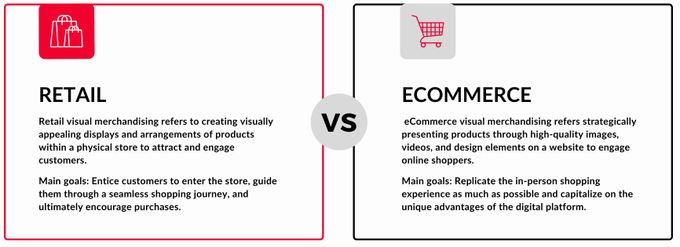Retail vs. eCommerce Visual Merchandising: Similarities and Differences
Updated November 19, 2024.

Visual merchandising is a crucial aspect of both traditional retail and the ever-evolving world of eCommerce. While retail visual merchandising has been around for decades, eCommerce visual merchandising has rapidly gained prominence with the rise of online shopping. Below, we explore the key characteristics, similarities, and differences between retail vs. eCommerce visual merchandising.
Similarities Between Retail and eCommerce Visual Merchandising
Despite their distinct environments, retail and eCommerce visual merchandising share a common purpose—captivating customers and driving sales. Here are the universal principles that bridge the gap between these two approaches:
- Capturing Attention Both types aim to attract customers' attention through eye-catching displays and appealing product presentations—whether it's an enticing storefront or an engaging website banner.
- Brand Image Retail uses store decor and displays to reinforce their brand identity, while eCommerce implements website design and imagery.
- Engaging Customers Visual merchandising is essential for engaging customers and encouraging them to explore products further.
- Customer Journey By strategically organizing products and creating a clear pathway, both types of merchandising aim to enhance the overall customer experience.
Differences Between Retail and eCommerce Visual Merchandising
While retail excels at creating immersive, tactile experiences, eCommerce harnesses the power of digital technology to provide convenience and personalization.
eCommerce vs. retail environments present different challenges and opportunities for visual merchandising, so your approach to each will be different. These are the main differences:
1. Customer Interaction
- Retail: Customers can interact with products directly. They can touch, feel, and examine the items, which creates a more immersive and sensory shopping experience.
- eCommerce: Online shoppers can't physically interact with products. Instead, they rely on high-quality images, videos, and product descriptions to simulate real-life appearance and experience.
2. Space and Layout
- Retail: Physical stores have limited space, so merchandisers have to strategically organize displays and shelving to ensure efficient customer flow and product placement.
- eCommerce: In the digital realm, physical space limitations don't apply. eCommerce stores utilize design elements like banners, popups, and featured product sections to enhance the online browsing experience.
3. Personalization
- Retail: Visual merchandising is generally targeted toward a diverse audience. Displays are designed to appeal to a broad range of shoppers without personalization to individual preferences.
- eCommerce: eCommerce excels in personalization. Online stores can tailor displays and product recommendations based on each shopper's browsing behavior, location, past purchases, and preferences.
4. Change and Flexibility
- Retail: Changing physical displays in a retail store requires effort and time. Visual merchandisers need to physically rearrange and update displays, which can be labor-intensive and time-consuming.
- eCommerce: In eCommerce stores, using digital displays provides unparalleled flexibility, thanks to the capabilities of AI. Merchandisers can quickly and easily update product images, banners, and other visual elements, allowing for dynamic changes in response to trends, promotions, and customer behavior.
Visual Merchandising in the Fast Lane: Navigating Retail and eCommerce
Retail vs. eCommerce visual merchandising share similarities and differences. By understanding the unique strengths of each approach, you can craft comprehensive visual merchandising strategies that cater to the diverse needs and preferences of modern consumers.
» Create an effective visual merchandising plan by leveraging the most popular visual elements





